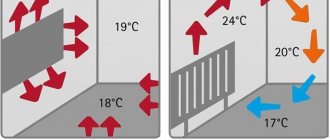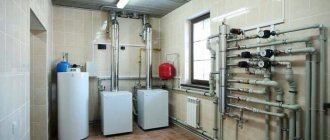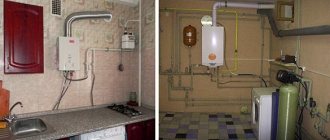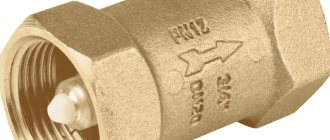One of the common problems with heating systems both in the private sector and large apartment buildings is incomplete heating of the radiators due to air accumulated in them. To quickly and easily solve this defect, a special valve was designed - the Mayevsky tap.
What is a Mayevsky crane?
In order to understand why a Mayevsky tap is needed, it is worth understanding the operating features of the heating system. A certain number of air bubbles are dissolved in the water that fills the heating devices. When they come together, they can form an air lock, preventing the battery from heating evenly and preventing the system from functioning properly. The problem can be solved by completely draining the fluid and refilling the system.
At the beginning of the 20th century, a plumber from Minsk named Roev invented the first primitive device with which it was possible to remove excess air from the battery without draining the water. A few years later, designer Ch.B. Mayevsky modified the valve. He increased its tightness, changed the structure to “cone to cone” and added a safe key to operate the system. This is how the Mayevsky crane appeared, which is now widely used when installing heating in offices and apartments.
Design of the Mayevsky crane
The official names of the device, which are mentioned in various documents, are a radiator needle air valve or a device for releasing air from radiators. Regardless of the name under which the mechanism is used, its design is simple, therefore, not only professional plumbers, but also ordinary users of residential and office premises know what a Mayevsky faucet looks like. The valve consists of:
- A housing that is made of metal or plastic.
- Rotating part.
- A conical screw with a head for a special key and thread for a screwdriver.
- Inlet calibration channel for air.
- An outlet channel with a hole of about 2 mm to remove air accumulated in the system.

Operating principle of the Mayevsky crane
Thanks to the structural features of the Mayevsky valve, it completely copes with removing excess air from the system without leaking coolant. The principle is a little similar to the operation of a conventional water mixer, after opening the valve, water flows. However, the system of how the Mayevsky crane works is somewhat more complicated:
- The valve is installed in the upper part of heating devices.
- The device is adjusted by a special locking screw, which can be driven with a special key or screwdriver.
- After turning the screw, a special plug opens, moving the air in the system.
- The air accumulates in a special sealed chamber of the device, separated by a cuff into which water cannot penetrate.
- Oxygen is discharged out through special grooves in the propeller body.
Composition and principle of operation of the crane
The design of the Mayevsky tap does not allow anyone to open it at any time. This is done for reasonable purposes, since if it can be opened easily and conveniently, everyone will begin to drain water from the radiators (especially residents of areas deprived of hot water supply), and this will cause heat loss. In addition, this design protects against children's pranks.
The design of the Mayevsky crane consists of:
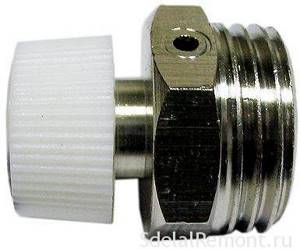
Mayevsky faucet with a special handle. The picture shows the drain hole.
Both parts are tightly connected. They are most often made from brass. This metal does not corrode, which allows the device to serve for a long time. Air masses are vented through a hole in the side of the housing with a diameter of 2 mm. When the valve opens, air escapes.
Obviously, due to the extremely small diameter of the air outlet hole, it is a weak point in the faucet, as it can become clogged, but cleaning it is easy. To do this, you need to open the valve and clear the holes from clogging using a regular needle.
Mayevsky taps can be opened in different ways - with a special key, a screwdriver, a wrench, or all of these at the same time. There are also taps that are opened with a special handle without any equipment.
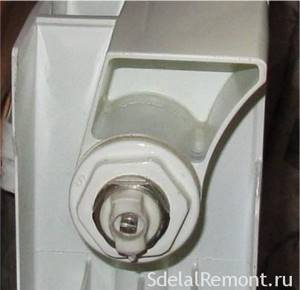
Mayevsky tap for a screwdriver or a key mounted in the radiator
There are also automatic Mayevsky cranes and their operating principle is similar. Only the automatic one opens on its own when air appears in the coolant. The device reacts thanks to a compartment inside it with a plastic float. When the compartment is filled with air, the float, using a spring structure, opens the air outlet. When there is no air, the float closes the valve.
The automatic option is suitable in cases where heating is installed in hard-to-reach places or when it is necessary to frequently release the coolant from air.
Types of Mayevsky crane
Almost 100 years have passed since the invention of the valve, and the concept of what a Mayevsky valve is has changed somewhat thanks to the achievements of modern designers. In a specialized store you can find three types of such a device:
- An ordinary manual tap that can be used to eliminate defects in the heating system as needed.
- Mayevsky's automatic faucet on heated towel rails and other equipment removes excess air in autonomous mode.
- A system with a safety valve against possible water hammer.
The devices differ in the material from which the main elements are made. Can be used:
- stainless steel;
- brass;
- cast iron;
- durable plastic.
The designs and type of locking mechanism differ:
- special screw with a slot for a screwdriver;
- 4- or 6-point key screw;
- non-removable handle that can be unscrewed without the use of tools.
Mayevsky manual crane
Initially, Mayevsky's manual tap was invented for cast iron radiators. This device has the simplest design and low price, due to which it is still used everywhere. The principle of its use is simple:
- The master or owner of the premises independently determines the uneven heating of the battery.
- Using a special key or screwdriver, the shut-off valve is turned, after which air begins to escape from the battery.
- Once the air flow ends, the valve rotates to the sealed position.
- The next time the system is aired, the operation is repeated.

Mayevsky automatic crane
A more convenient version is Mayevsky’s automatic battery-powered faucet, which is often installed in private homes with an individual heating system. The device operates offline according to the following principle:
- The cylindrical brass device is made with an additional chamber with a float, which is connected to a needle valve.
- When air enters the system, it moves a float, which opens the shutter valve.
- When air is removed, the float lowers and the valve closes automatically
- That is, the device works without human intervention. This device is more convenient to use, but it is significantly more expensive than its manual counterpart.

Mayevsky tap with safety valve
In relatively fragile heating systems made of polypropylene or metal-plastic, it is recommended to install an improved Mayevsky manual tap for heated towel rails with a safety valve that protects heating equipment components from water hammer. In such a device, when the coolant pressure in the system increases above 15 B, the safety valve is activated. This begins bleeding water from the system to compensate for the increased pressure.
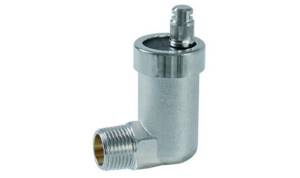
Types and mechanism of action
Given this scope of use, it would be surprising if there were one crane model for all situations. The principle of operation remains the same, but some nuances change. Depending on various factors, it makes sense to install one or another crane model
Hand tap
The manual tap is controlled by a square screw. The inspector opens the tap 1-1.5 turns and the air is squeezed out by a stream of water. Until water starts flowing from the tap, the device remains open. A manual crane is the simplest and cheapest version of the Mayevsky crane. It makes sense to install it on household radiators located in easily accessible places.
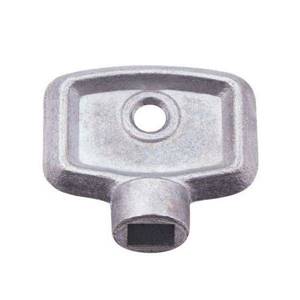
Key for Mayevsky crane
Auto
The automatic tap is equipped with a plastic float. When the faucet is filled with water, the float closes the outlet of the faucet. As soon as air collects at the top of the valve, the float drops along with the water level, and the air is released into the atmosphere. Such devices are more expensive than manual taps, but are quite affordable.
So why not install such valves everywhere, neglecting manual analogues? The fact is that the main use of Mayevsky cranes is apartment buildings. And the lion's share of apartment buildings is heated using centralized heating systems. The pipes of heating plants quickly deteriorate, becoming overgrown with rust and filled with debris. As a result of stray currents, leaks regularly occur; when eliminating leaks, the tightness of the system is broken, all this adds quite a lot of various types of debris to the system.
Most of the contaminants are filtered out at the entrance to the building, where a mesh filter is provided, but the smallest particles, including rust, still find their way into the internal heating system. As a result, the hole in Mayevsky’s tap regularly becomes clogged. It is not known what is easier when heating systems are constantly airing: bleeding the air manually or regularly cleaning the valve.
In addition, the automatic valve is susceptible to breakdown due to pressure surges in the system. And for centralized systems, small water shocks have long become a common reality
In general, installing automatic taps is profitable and convenient, especially in houses with an independent connection system. With this option, the heating system and the heating plant are connected using a heat exchanger and are not hydraulically connected. That is, it is possible to supply prepared water to the batteries with a truly minimal amount of polluting particles. In addition, the hydraulic pressure in such a system is constant, since it does not depend on many neighboring houses.
An automatic tap can also be installed in a private home, but here again the problem of water preparation arises. It is too expensive to purify water at a sufficient level. Even within multi-apartment buildings, the installation of independent connection systems will significantly increase the cost of the final construction cost, and therefore of each individual apartment. As for private households, installing such systems just for the sake of automating air release seems completely unjustified.

Mayevsky automatic crane
With safety device
Valves with a safety device are designed specifically for apartment buildings with central heating. These are the same Mayevsky manual taps, which, however, have a protective system against increased pressure in the network. As already mentioned, for centralized heat supply, pressure surges in the network are considered the norm. But excess pressure can lead to radiator failure. A simple aluminum radiator can simply rupture as a result of water hammer. Therefore, during installation, a Mayevsky crane with a safety device is provided.
If the pressure in the system exceeds 15 atmospheres, the tap automatically opens, releasing the water. Of course, this may be associated with some inconvenience: few people would like to see a small puddle under the radiator. But there will be little water, and the benefits from the device are quite significant.
How to choose a Mayevsky crane?
After finding out what a Mayevsky crane is and for what purpose the device was developed, it is worth taking a closer look at the rules for choosing a unit. They are based on the features of a specific heating system:
- In central heating systems with relatively contaminated water and high pressure of about 15 At, it is not recommended to install such a device. In private homes you cannot do without such a valve.
- The diameter of the coupling of the selected model must completely coincide with the diameter of the radiator. Otherwise, the unit simply cannot be connected.
- The material used affects the quality and durability of use. Many professionals recommend purchasing brass alloy products. To enhance its aesthetic appearance, the main device can be hidden in a plastic cap.
- The choice of a Mayevsky crane is also based on the type of control. Automatic devices are more convenient, but more expensive. Manual models may have a special removable rotary key or a stationary handle to operate the shut-off valve.
Ball valve design and types
Ball valves are usually used for installation on radiators. This is a relatively simple device that consists of the following elements:
- gate;
- rod with seal;
- sealing washer;
- sealing seats;
- housing and adjusting nuts;
- control handle;
- frame.
The shutter is a metal ball with a hole in the center. The handle allows you to move the shutter to one of two positions: “closed” or “open” - by turning it 90 degrees. Such a simple device ensures a reliable design and a relatively low price.
Most often, ball valves are made of durable brass or similar alloys; durable modern plastics and effective lubricants are also used in their production. Another advantage of the ball valve is its compact size. For a small device it is easier to choose a suitable place in the system.

The diagram shows in detail the design of a ball valve, which allows you to understand the operating principles of this simple and reliable design
Depending on the throughput there are:
- full bore;
- standard;
- partial bore ball valves.
The first pass 90-100% of the coolant flow, the second - about 70-80%, and the third - only 40-50%. For installation on a radiator, it is recommended to install full-bore structures that will ensure that there are no significant obstacles to the coolant, which has a beneficial effect on the efficiency of heating the room.
On sale you can find ball valves made of plastic, but they are not suitable for hot water supply or heating pipelines because they do not withstand high temperatures. Brass ball valves for radiators are also distinguished by installation method:
- coupling;
- flanged;
- welded;
- combined.
Coupling taps are usually recommended for use when installing heating systems; they are also suitable for water and gas pipelines. They are used both in residential premises and in the arrangement of public buildings. These are small devices, easy to use and very reliable. They are easy to install and usually do not require special, complex equipment. Such structures are mounted on pipes with a cross-section of no more than 40-45 mm.
When choosing valves for larger diameter pipelines, it is recommended to pay attention to flanged designs. They are designed for pipelines with a diameter of more than 50 mm. During installation, be sure to use special sealing gaskets to ensure sufficient strength and tightness of the connection between the tap and the pipeline. Flanged ball valves are strong enough to be used in heating systems.
There are collapsible flanged valves and non-separable ones. The first ones have a collapsible body, which will be very convenient when replacing worn or damaged parts. Most often, replacement requires a gasket, sometimes you have to install a new valve, etc. Non-separable flanged valves have a one-piece body. If it breaks, you have to completely replace the entire structure.
Welded structures are installed by welding, as the name implies. Since dismantling such a structure cannot be called simple, devices of this type are installed in places with limited access. Ball valves should only be welded by specialists who have the necessary qualifications.
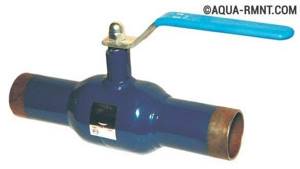
A weld-on ball valve is quite difficult to install because it requires skilled welding. Such devices are installed in places that cannot be easily accessed.
Combined designs can combine several installation methods. Such valves can be straight-through, angle, multi-way (for example, three-way). The latter type is not often used in the installation of heating systems, since it is used in systems where mixing or redirection of various media is necessary.
Although it is best to use taps made of brass or its alloys for heating systems, silumin control structures that are less durable and cheaper can be found on sale. Outwardly, they are very similar to brass taps and can be passed off as expensive originals by unscrupulous sellers. Before purchasing, you should consult with a professional craftsman who will help you identify a fake and make the right choice.
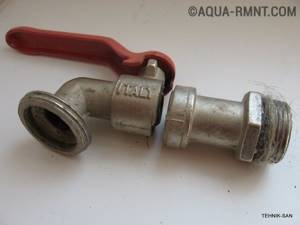
Ball valves made of silumin are inexpensive, but are characterized by low resistance to loads and corrosion. Such designs should not be installed on radiators.
Silumin structures in heating systems can withstand loads for no more than a year, then they break. This material is extremely poorly resistant to increased loads, such as water hammer, and is noticeably susceptible to corrosion. Sometimes a silumin tap for a heating radiator simply falls off the pipeline when the tap is closed or opened. This can cause significant and serious burns. In addition, when using low-quality taps, leaks often occur. As a result, more than one floor may be flooded.
Before purchasing heating pipes and taps, you need to calculate the number of radiator sections to ensure good heating of the rooms. You will learn how to do this correctly from our article:.
How to install a Mayevsky crane?
To ensure uninterrupted and proper operation of the entire heating system, the air exhaust device must be installed on:
- all radiators included in the system.
- loop capacitors;
- heating coils and register.
A plumber can professionally install the device, although if you have certain knowledge, the owner of the premises can also cope with the work. The basic installation rules are:
- It is better to install the Mayevsky tap on a cast iron radiator in the warm season, when it is possible to completely drain the water.
- All radiators are removed from the hooks and freed from coolant.
- According to the installation rules for the Mayevsky tap, its installation is carried out at the top point of the radiator, on the opposite side from the pipe inlet.
- If installation of additional equipment is not provided in the top plug, then drill a hole equal in diameter to the air vent valve.
- Install the equipment with the outlet pointing down and away from the wall. If installation is carried out on plastic pipes, a special fitting will be required.
- The radiator is returned to its place, connecting to the pipeline.
- The system is filled and ventilated.
How to install a program on MacOS that was downloaded from the Internet

Apple is committed to keeping the data on its devices as secure as possible, including computers running MacOS. As you know, all applications that make it to the App Store for Mac computers are carefully reviewed for malicious code that can slow down computer performance and cause data loss for people who install these programs. But at the same time, it is possible to install, among other things, programs that are downloaded from the Internet, if you change some operating system settings.
Important: If you are an inexperienced Mac user, it is highly recommended not to allow installation of programs from any developer.
1. Why “The program cannot be opened” on Mac 2. How to allow installation of programs from any developer in MacOS - First method - Second method
If you download a Mac application to your computer simply from the Internet, most often this will result in an error: “The program cannot be opened because its author is an unidentified developer.” This means that Apple has no knowledge of who created the app or how clean the code is.
Before the release of the MacOS Sierra operating system, Apple allowed you to be less wary of applications downloaded from any source. The user could select “Allow the use of programs downloaded from any source” in the security settings. There is no such option now, and in new versions of MacOS it is much more difficult to figure out how to install an application that was simply downloaded from the developer’s site on the Internet, and not through the App Store.
How to Allow Installation of Programs from Any Developer on MacOS
There are several ways to do this. One option is that you generally want to keep your computer secure, but make exceptions for certain applications. And the second involves completely disabling the protection that checks developers before installing the program.
First way
If on a computer running MacOS Sierra (and higher) you download an application from the Internet and transfer it to the “Programs” folder, then when you try to launch it, you will receive the information message “The program cannot be opened because its author is an unidentified developer.” The following will contain information about how and when the program got onto your computer. Click “OK” to close this information window.
Now in the upper left corner you need to click on the apple icon, and then select “System Settings” from the drop-down menu.
Once in the settings, go to the “Protection and Security” section.
Here you will need to first unlock access to the settings. To do this, click on the lock icon in the lower left corner. A window will appear to enter your account password - enter it and click “Unprotect.”
Having successfully removed the block from the settings, all that remains is “Confirm login” for the program that was blocked. Click on the appropriate button.
Please note: Make sure you are granting access to the exact program you wanted to run.
By clicking on login confirmation, you let the operating system know that you know the developer who signed this application. The information message that was at the very beginning will appear, but it will contain the “Open” item, which will allow you to launch the downloaded program.
Important: If you later download another application from the same developer to your computer, the operating system will immediately offer to launch it without performing the steps described above, since the developer will already be on the trusted list.
Key for Mayevsky crane
To use manual models of equipment, a special key or valve is required. It comes complete with the mechanism itself and most have a typical design with a rectangular cross-section. When the valve is turned, the valve begins to bleed air from the system. However, it is not uncommon for the key to be lost or left with the previous owners of the premises, and the new owners do not know how to open the Mayevsky tap. In this case, in any hardware and specialty store you can purchase a standard key suitable for most models from:
- durable polymer;
- metal
Features of operation

Let's look at how to use the Mayevsky crane at work. First, place some container under the radiator and prepare a dry rag. Using a special key or a simple screwdriver, turn the locking screw. In this case, you need to turn counterclockwise and half a turn. The air will start to come out, and then the water will come out. You need to wait until the liquid flows without interruption. After this, tighten the screw.
A case where the air has been removed but the radiator remains cold indicates a clogged system.
In order to clean a clogged battery, you need to seek help from a plumber.
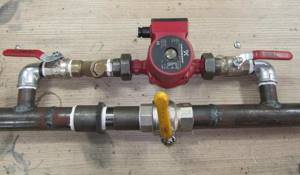
Note: If the heating system has a pump operating on the principle of forced circulation, then it will need to be turned off 10 minutes before the air lock is released. If the pump is turned on, the water flow will distribute air throughout the system and it will not accumulate in the upper part of the battery.

If the hole in the Mayevsky tap is clogged, you can try to clean it yourself with a sharp object. Also, if the tap is not used for a long time, the adjusting screw will be difficult to rotate due to possible corrosion formations. If such a problem occurs, use a product such as WD-40 spray lubricant. It works very quickly and makes it easy to unscrew the screw.
Also, at the end of the heating period, the screw should be lubricated. In this case, there will be no destruction of the thread under the influence of the coolant.

If there is a need to replace the Mayevsky tap, you need to use two adjustable wrenches. One key holds the radiator cap, and the second unscrews the valve. If this is not observed, then when unscrewing the tap, the plug may loosen, which will lead to a leak.
If you take care of this device, do routine diagnostics and cleaning, it will last a long time without any problems.
Mayevsky tap - how to bleed air from the battery?
With the onset of cold weather, instructions on how to use the Mayevsky tap will be useful to many homeowners. The device is used in the following sequence:
- Turn off all pumps that increase the circulation of coolant in the system.
- Turn the key or valve to open the shut-off valve counterclockwise.
- After turning, air will begin to escape from the system with a characteristic hissing sound. There may be slight drops or splashes of warm water, so you can place a container or cloth under the device.
- The completion of the process will become clear by a uniform stream of water supplied without pressure or hissing.
- At this moment the valve is closed.
- After a few minutes, check that the battery is warming up evenly.
How to open the Mayevsky tap without a key?
If the instructions on how to bleed air from a particular Mayevsky tap do not include the use of a special key, or it is lost, then you should use the following methods:
- The rotary mechanism may have a special slot for a flat-head screwdriver. If there is one, then the screwdriver is inserted into the groove and carefully turns the mechanism in the desired direction.
- You can try to turn the valve with an adjustable wrench or pliers, which in some cases can replace a special wrench.
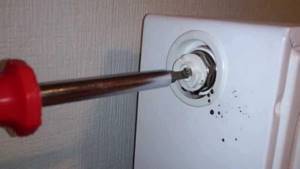
How to open the Mayevsky valve?
The heating system and its installation are extremely important for any home. This issue is especially acute in country houses that have autonomous heating. However, even with the most gentle and correct operation, minor problems may inevitably arise, even if the installation was carried out correctly.
Installation diagram of the Mayevsky tap: Figure 1 - with a vertical heating system, Figure 2 - with a horizontal heating system.
So, one of these situations is the accumulation of air in the heating system. This happens irreversibly, and therefore there is no point in making a problem out of it.
But still, the outflow of air masses must occur. It is precisely for these purposes that any heater design includes a Mayevsky tap.
It is designed to remove this very excess air. It does not matter how long ago the device was installed. But how do you figure out how to open it? And how can you do this yourself, without outside help?
How to open the Mayevsky tap yourself
It happens that the instructions or drawing for the water heater cannot be found. And therefore its structure becomes somewhat unclear.
But you can completely cope with this even without hints that reveal the device’s structure. In order to open the Mayevsky valve and remove air masses, you will need the following tools:
- adjustable wrench;
- screwdriver;
- pliers;
- water container.
Construction of the Mayevsky crane.
First, an initial examination of the Mayevsky valve is carried out, which will allow you to most accurately select the necessary instrument. Its structure is of primary importance. So, if there is a hex nut (the most common device), then you will need an adjustable wrench or wrench. And in the case of a slot (such a device is a little less common), a flat-type screwdriver will come in handy. If you have a ribbed head, everything will be very simple. All you need is pliers, and sometimes you can do it with just your hands.
You need to prepare a container in advance where the water will drain, since after the air comes out, a small stream should appear. It is worth preparing for this after opening the tap with the specified tools.
Now the valve needs to be turned counterclockwise several times. The main thing is not to overdo it, because there is no need to unscrew it completely. If you can’t unscrew the tap, then most likely it is rusty. You can try using kerosene, which will soften the threads. However, it is necessary to measure the force so as not to accidentally break the thread.
The tap is unscrewed, and therefore it is necessary to allow the air accumulated there to escape. How to understand that the process has completed? Immediately after the air comes out, liquid will begin to flow. As mentioned earlier, you need to place a container for it. After this, the tap is gradually closed. It is important that no water flows during the closing process. Installation of the unscrewed valve is carried out according to the same scheme, but only in reverse order.
This is a diagram of how to open the valve in the heater. Thus, you can open the Mayevsky tap independently and without much difficulty. One has only to add that all manipulations must be carried out very smoothly and carefully, because its design is very fragile and even delicate.
Share a useful article:
bezsantexnika.ru
Mayevsky's faucet does not bleed - what to do?
In some situations, if the Mayevsky valve is installed on an old cast-iron battery, then after opening the valve, air discharge may not occur. In each situation, solving the problem must be approached comprehensively, alternately checking one of the methods presented below:
- The valve does not open due to a rusted connection. Then you can try to lubricate this place with kerosene or special automotive lubricant, waiting 2-3 minutes. After this, you can try to turn the valve again, but carefully so as not to strip the thread.
- Perhaps the air outlet hole is clogged with dirt particles from the coolant or rust. Then you need to unscrew the stem and try to clean it with a thin metal wire with a curved end or a regular sewing needle. At the moment of supplying air and water, it is important to have time to tighten the rod and place a container for draining.
The Mayevsky tap is leaking - what to do?
In a working valve, there is no possibility of water leakage in either the open or closed state. A special rubber seal is responsible for the tightness. If, however, drops periodically appear from the air release valve, you can use one of the following methods to eliminate the leak:
- If drops appear in the thread area, then you can try tightening the device itself with a wrench to the radiator by about 10-20%.
- Perhaps the leakage problem lies in clogged internal threads and excess pressure on the device. Then the entire system can be removed (after draining the water), cleaned with a brush and put back in place.
- If the problem is the wear of the rubber seal, then it is easier to replace the valve with a new one.
How to replace the Mayevsky tap?
There are alternative options for getting rid of air locks in the heating system. A replacement for the Mayevsky tap on the battery can be:
- A conventional ball valve installed at the top of the radiator. However, when it is opened, a significant portion of the coolant may leak out.
- An air separator, which is installed on pipes near the boiler. This device is capable of independently differentiating dissolved gases from the coolant and removing them through an air vent. An additional advantage of the device is the purification of water from sand, rust and other slags and impurities.
Advice for business
Before deciding to purchase air exhaust devices, it is recommended to carefully study the arrangement of devices in the heating circuit.
Depending on the degree of freedom of access to the equipment, Mayevsky cranes of a suitable modification should be installed.
Where it is difficult to work with a screwdriver, turnkey models are better suited, and where it is difficult to work with keys, it is wise to place automatic devices. Careful analysis will help make device maintenance more efficient and save on purchases.
Manual devices have the most simplified design, for example, compared to automatic air vents. But, as practice shows, simplicity is the key to reliability.
If cast iron radiators are used in the heating system, manual taps are more reliable for such a system than automatic ones. Meanwhile, the degree of reliability of the design largely depends on the quality of the metal (brass) from which the air vent is made.

